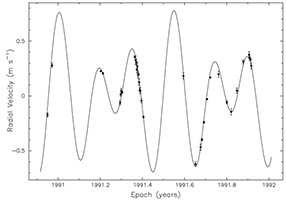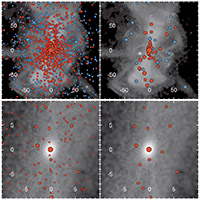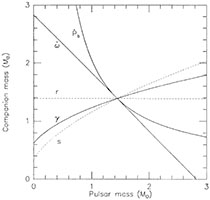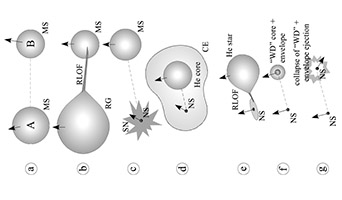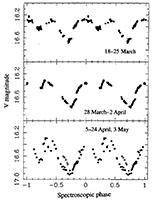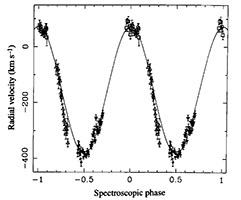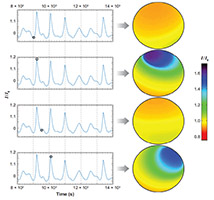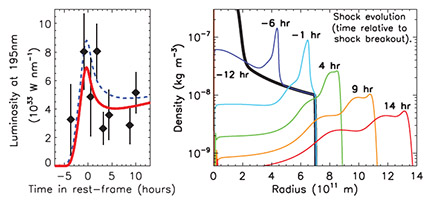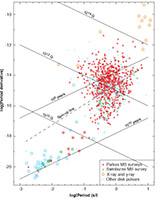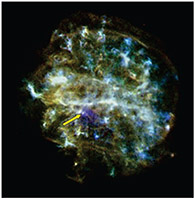Astronomy 61:
Current Problems in Astronomy and Astrophysics
Spring 2014
Prof. David Cohen
Archive of papers
|
For week 13, Jamie has chosen "Discovery of pulsar planets," Wolszczan, New Astronomy, 56, 2 (2012). Jamie also recommends we take a look at this other paper by the same author, and specifically, that we study Fig. 1.
For week 12, Randy has chosen a paper related to gravitational waves: "Compact binaries ejected from globular clusters as gravitational wave sources," Bae et al., MNRAS, in press (2014).
We had no class meeting during week 11.
For week 10, Rebeka has chosen two short papers on quark stars. We'll concentrate on the first one: "The missing compact star of SN1987A: a solid quark star?," Liu et al., MNRAS, 424, 2994 (2012). It's a short theoretical paper that looks into whether the non-detection of a pulsar in the remnant of this nearby, 27-year-old supernova could indicate that it left a quark star behind. And for some background and context, we'll also read "Strange quark matter in stars: a general overview," Schaffner-Bielich, Journal of Physics G, 31, 651 (2005). You might find the short and relatively clear (given the subject) Wikipedia page on quark stars to be useful too.
For week 9, Brady has chosen "A Population of Relic Intermediate-mass Black Holes in the Halo of the Milky Way," Rashkov & Madau, Ap.J., 780, 187 (2014).
For week 8, Zack has chosen "Binary Pulsars and Relativistic Gravity," Taylor, Nobel Prize Lecture, 1993. You might want to consult the short discovery paper, by Prize co-winner (and grad student) Russell Hulse. And here's some good information about gravitational waves.
For week 7, Rebeka has chosen "Binary pulsar J0737-3039 - evidence for a new core collapse and neutron star formation mechanism," Dall'Osso, Piran, & Shaviv, MNRAS, 438, 1005 (2014).
For week 6, Catherine has chosen "Dynamical evidence for a black hole in the eclipsing X-ray nova GRO J1655 - 40," Bailyn, et al., Nature, 378, 157 (1995). (Note that Cornell doesn't have a regular subscription to Nature for issues older than 1997. I was able to get a copy via Tripod, but to spare you the hassle, you can just use the pdf I downloaded.)
For week 5, Luke has chosen "High-resolution simulations of the head-on collision of white dwarfs," Garcia-Senz, et al., Monthly Notices of the Royal Astronomical Society, 436, 3413 (2013).
For week 4, David has chosen the first two sections of "Pulsating White Dwarf Stars and Precision Asteroseismology," Winget and Kepler, Annual Reviews of Astronomy and Astrophysics, 46, 157 (2008). Read just the first two sections of this long and comprehensive review. This reading provides a relatively simple overview of white dwarfs and some of their "applications." Obviously, you can learn more by reading ahead, perhaps focusing on the figures (don't be discouraged by the incomprehensibility of fig. 2 though).
For week 3, Matt has chosen "Supernova Shock Breakout from a Red Supergiant," Schawinski et al., Science, 321, 223 (2008). Read the paper itself first, but then read the supplemental information too. Matt and/or David will send out some guidelines by Tuesday night about what parts of the supplemental information you should focus on (some of it can be skimmed).
For week 2, Jamie has chosen "Observational Properties of Pulsars," Manchester, Science, 304, 542 (2004). update: Jan. 29 Multiple observation taken over several years can be turned into movies of the Crab and Vela pulsar wind nebulae (both from Chandra (X-ray) and HST (optical) images). I recommend this Hubble Crab. The Crab Pulsar was formed in a supernova explosion in 1054 A.D., that left behind this nebula. You can see that it's on a slightly bigger scale than the PWN in the movie. And here you can see that the nebula is noticeably expanding. It's expansion age is just about 1000 years, as is the spindown age of the pulsar. The paper mentions pulsars as clocks and an array of pulsars as setting a reference frame. Here is a famous plaque affixed to the Pioneer 10 Spacecraft, launched in 1972, and now beyond the solar system. The irregular rays emanating from a point to the left of the Eurocentric, hetero-normative Ken and Barbie each represent a different pulsar's position with respect to Earth. So the aliens will know where the spacecraft came from. On each pulsar's ray there is a binary number representing the pulse period of each pulsar (in units of the hyperfine transition of hydrogen (that's the 21 cm line transition)). Carl Sagan, who designed the plaque, published an article - in Science coincidentally - about it. See the bottom of p. 1 and top of p. 2 for an explanation of the use of the pulsars as beacons and clocks.
Assignment: For week 2, Jamie will pick a paper for us all to read about some aspect of the compact objects topic. A good place to start (for other topic-searches, too) is the Annual Reviews of Astronomy and Astrophysics, to see if there's a recent review article on the topic in question. We can certainly read such ARAA review articles in class, but they tend to be long - so we could split one up to cover two weeks or we could read just a portion of one (like the Introduction). But probably the best way to use these ARAA review articles to to find classic/important papers, cited in their introductions.
Assignment: For week 1, please read this webpage carefully, and explore the links. Then browse or search ADS, astro-ph, or other sources and find two papers that you think are interesting. You don't have to read the papers, but read the title, the abstract, and spend a couple minutes skimming the paper, paying special attention to the figures and their captions. Then email me (David) the titles, authors, and reference (journal, volume number, page number, year) of the two articles. Come to class on Friday prepared to say a few words about why you found your two papers to be interesting. At the end of class, we'll vote on the papers and choose one to read for next week. ...that will hopefully help us choose a theme for the semester also. We'll have a broad theme so that the papers we read will be related to each other and thus the knowledge and expertise you develop will build on itself throughout the course of the semester and by the end, you'll be an expert on our chosen topic. |
Back to the main class page.
Comments or suggestions to David Cohen.
Last modified: April 26, 2014
